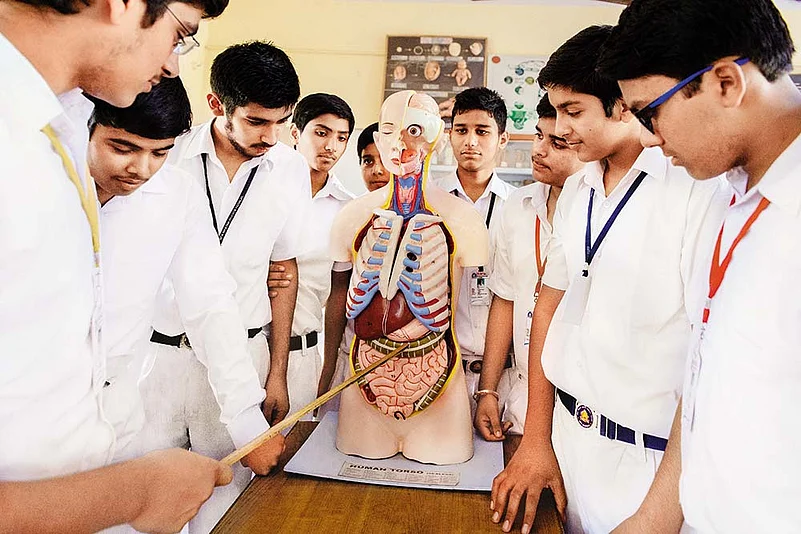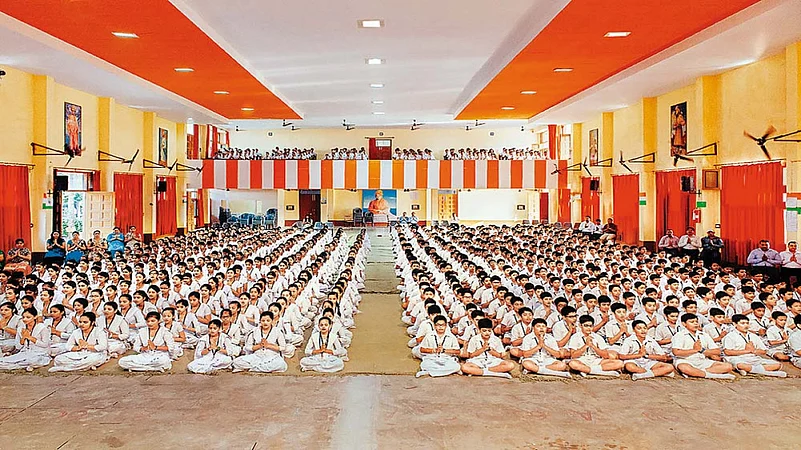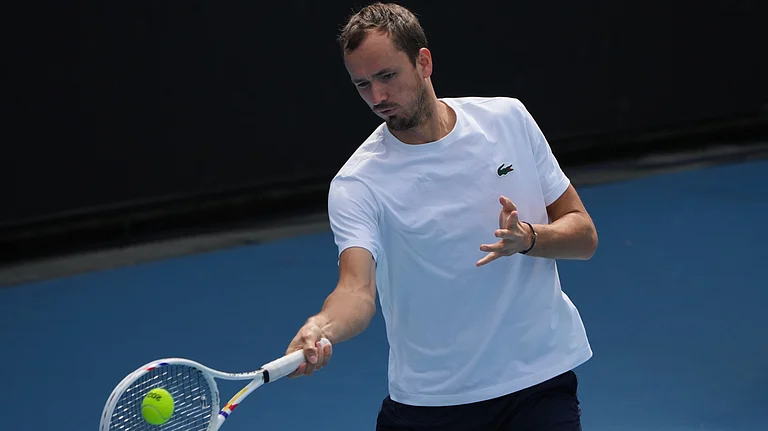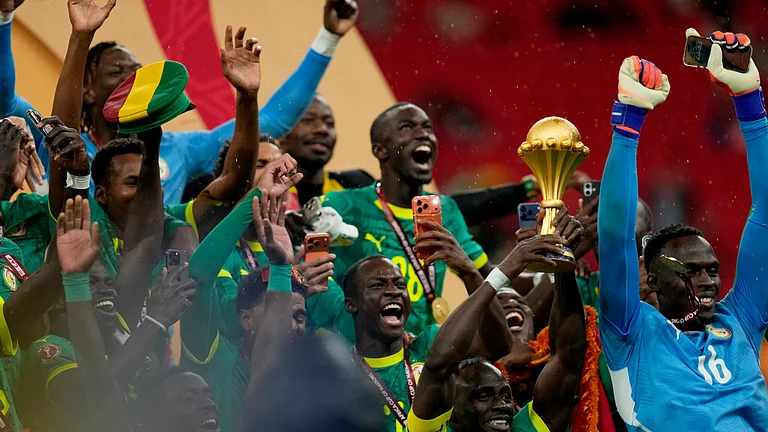It’s 8. 30 in the morning, and the scene inside the GLT Saraswati Bal Mandir School is a world removed from the bustling traffic just outside—a narrow street in South Delhi’s Nehru Nagar. An air of tranquility rests over the morning assembly in the courtyard. A young student lights a lamp in front of three garlanded photographs—Goddess Saraswati, the symbol ‘Om’ and Bharat Mata—murmuring a prayer. Hands clasped, around 100 students standing in lines follow suit, as Vedic chants play loudly in the background.
After a 10-minute long prayer session, they are shepherded into their classes by a teacher in charge of ‘discipline’. “We strive to instil discipline in students,” says principal Bela Mishra. “Because of Covid restrictions, we have pared down assembly to 10 minutes. It usually runs into 20-30 minutes, with shlokas, prayers and stories of historical figures,” adds Mishra, who joined the school in 1991. GLT Saraswati Bal Mandir is among thousands of schools run by Vidya Bharati Akhil Bharatiya Shiksha Sansthan, the educational wing of the Rashtriya Swayamsevak Sangh.
Set up in 1971, the school now has 2,000 students, says Mishra, insisting that the ideology of its parent organisation doesn’t come in the way of its functioning. “We are a normal school like any other. It is a matter of pride that our thrust is on Indian culture and values,” she says. On the walls of the three-storeyed building are emblazoned teachings and photographs of RSS ideologues K.B. Hedgewar and M.S. Golwalkar. Idols of goddess Saraswati in various hues can be spotted around corners and in the courtyard. The many paintings on the inner walls depict scenes from the Mahabharata and Ramayana. A board outside a classroom announces a prayer schedule: Tuesdays, Hanuman Chalisa; Wednesdays, patriotic songs; Thursdays, Ramayana and on Fridays hymns from the Bhagavad Gita.
Vidya Bharati set up its first Saraswati Shishu Mandir school in Gorakhpur, Uttar Pradesh, in 1952. Now, it has 12,828 formal schools across India; in all, 3,465,631 students attend them. The schools also focus on yoga, physical education, music, Sanskrit, ethics and spiritual education.

Morning assembly in GLT Saraswati Bal Mandir, New Delhi
“We have over 300 Muslim students out of 2,000,” says Mishra proudly. Najma, a parent, testifies that her son Shazir Ali, a class XII student and school topper, never faced any discrimination on account of his religion. The school has provided unstinted support to Ali, says Najma. “When we shifted to Delhi from a village in Moradabad, it wasn’t easy to get admission for my son in Delhi schools. This school gave my son a chance to fly high. His siblings also study here on a nominal fee,” she adds.
Najma also has no qualms about her children chanting shlokas of Gayatri Mantra and Saraswati Vandana in school, which also conducts monthly ‘havans’ to celebrate birthdays of students in accordance with Vedic rituals. “My son loves to participate in ‘havans’ and even keeps the Bhagavad Gita in his book rack. All religions teach us to love each other,” says Najma.
Apart from formal schools, the Vidya Bharti group also conducts informal education centres—called Sanskar Kendras. It has 6,418 Sanskar Kendras and 4,935 Ekal Vidyalayas in total.
RSS leader and its national media head Sunil Ambekar says that Vidya Bharati schools have been a boon for children from underprivileged backgrounds. “Vidya Bharati’s aim was to provide affordable and quality education to children in far-flung areas, where they had limited access to government schools. Another focus is the curriculum. For long, our education was not rooted in ancient traditions. Vidya Bharati initiated research-based practices,” says Ambekar.
Ekal Vidyalayas are run by RSS-backed Akhil Bharatiya Vanvasi Kalyan Ashram (ABVKA), which works among tribals. ABVKA vice president Kripa Prasad Singh says it provides education to 14, 9616 tribal students. “One teacher takes a class for 30-50 village children for two hours under a tree. They are taught about Indian gods, rivers, heroes, mountains, numbers….” While there are allegations that Ekal schools are established as missionary institutions in tribal areas, Singh says they are working to protect tribal rights. “Services of the Church are meant to convert tribals to Christianity, whereas we work to protect their basic rights,” he claims. Schools under Vidya Bharati, however, are inclusive. “In Nuh village, we have 40 per cent Muslim children in a school. The father of a Muslim student, when criticised by some in the community for participating in a school function, proudly retorted that the school has imparted quality education to his son,” says Ravi Kumar, in charge of such schools in the state.

Prayer schedule in GLT Saraswati Bal Mandir, New Delhi
Row Over Curriculum
RSS-run schools have been charged in states like Kerala and West Bengal with a saffronisation of its text books. In 2018, the West Bengal government ordered closure of 125 RSS run schools in the state, alleging distortion of history in its text books. In 2017, Kerala, too, witnessed protests by parents and activists over text books.
State governments have deplored the wrong depiction of Indian history and culture in the Vidya Bharati text books. Most of these schools are affiliated to the Central Board of School Education, various state boards and the National Institute of Open Schooling. Apart from the curriculum, students from standards 4-12 are introduced to a series of books called Bodhamala, published by Haryana-based Vidya Bharti Sanskriti Shiksha Sansthan, in Hindi, English and various regional languages. The Bodhmala series has chapters on topics like ‘Mother India’, ‘brave sons of Mother India’, India’s knowledge system and cultural heritage, epics and history, ‘Vasudhaiva Kutumbakam’ and India’s scientific tradition.
For instance, the Bodhmala for Class VIII claims that Mansarovar (Tibet), Kailash Parvat (Tibet), Pashupatinath and Mt Everest (Nepal), and Nankana Sahib and Sadhu Belo (Pakistan), belonged to India in ancient times. A paragraph in Class VII Bodhmala reads, “Our country’s ancestors spread their knowledge across the world.… Maharishi Agastya, Guru Nanak Dev, Gautam Buddha, Swami Vivekananda, Swami Ramtheerth and Mahatma Gandhi are examples of such great men. These men spread our culture…traces of which can still be found in countries.” It further adds, “Present day Cambodia is the westernised form of ‘‘Kambuj’”. About China, it claims that “Tatari genealogy can be traced back to the native man called ‘Avar’, who was the son of Pururva. It claims that the name China/Cheen is derived from Sanskrit”.
Vidya Bharati also publishes three books for teachers: Praveshika, Madhyama and Uttama, and both teachers and students have to take an annual exam. These books devote chapters on RSS leaders K.S. Hedgewar and M.S. Golwalkar. While their content has drawn criticism from many historians for gross distortion of history, its leaders dismiss such claims.
Sudhakar Reddy, Vidya Bharati’s central publicity chief, says that “Countries like Burma, Pakistan, Bangladesh, all were part of India’s culture. Akhand Bharat is a cultural entity. Bodhmala talks about how all these countries broke away from Bharat,” he says, adding that RSS leaders like Savarkar and M.S. Golwalkar should be taught along with Gandhi and Ambedkar.
With RSS-run schools on an expansion mode, many historians have flagged it as a dangerous project with the potential to deepen rifts among communities.
Historian S. Irfan Habib says that a false narrative of history will create a divisive society. “It’s a serious issue that history is being distorted and fed to young minds. They will grow up with an absolutely outrageous vision of India, India’s past, present and future. This poses a serious threat to our social fabric,” says Habib.
Shriram Araokar, All India General Secretary of Vidya Bharati, spiritedly contests the view: “If an education system is based on the knowledge system of a country, what is there to be ashamed of? We have never hurt other religions and faith, so why is it called saffronisation?” National Book Trust chairman Govind Prasad Sharma, a former president of Vidya Bharati, concurs. “We have to teach our children about Indian culture. It is not there in other books. Today if you ask children about the number of Vedas, puranas, or Upanishads or about the Gita, Ramayana or Mahabharata, they will be in the dark. How can they be part of the country till they know these?” he asks.

A biology class in Gita Niketan Awasiya Vidyalaya
NEP & RSS Schools
While the New Education Policy (NEP) passed by the Union government was welcomed by the RSS and its affiliates for incorporating many of its suggestions, critics say that a new curriculum will be in line with the Vidya Bharati schools.
As a committee has been instituted to revise the NCERT syllabus, Sangh leaders say that they are hopeful of an overhaul of the curriculum. A 12-member panel is headed by former ISRO chief K. Kasturirangan, who also led the drafting committee of the NEP 2020.
NBT chairman Sharma, a member of the panel, says that as the National Curriculum Framework (NCF) was last prepared in 2005 under the UPA government, it needs to be reviewed immediately. “It’s imperative that the Indian knowledge system, no longer part of mainstream education, should be taught in our syllabus. It needs to be integrated with the system. I would suggest including Vedic mathematics…you can solve maths problems in two minutes where normally it takes half an hour,” he says.
RSS outfits such as Bharatiya Shikshan Mandal (BSM), Shiksha Sanskriti Utthan Nyas (SSUN) and Bharatiya Bhasha Manch have been actively engaging academics from across the country to get feedback on educational reforms. SSUN secretary Atul Kothari says that if Ramayana and Gita can be taught in foreign countries, it should be a part of the curriculum here as well.
“The syllabus, currently theory-based, should be based on real-life experiences like those of the Indian knowledge system. Our economy was very strong in ancient times. It’s not there in today’s syllabi. Some of the current syllabi gives wrong information about people who sacrificed their lives for the country. It needs to be corrected,” says Kothari.
(This appeared in the print edition as "Bharatavarsha In Palimpsest")

























